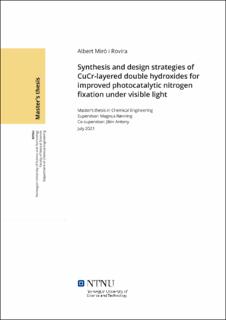| dc.description.abstract | Ammonia is one of the most important chemical commodities in the world. The synthesis of this substance currently relies on the Haber Bosch process, which is a very energy-intensive process. Due to its importance and magnitude, this chemical sector has a large carbon footprint and is a significant emitter of greenhouse gases, contributing to global warming. A sustainable alternative to conventional ammonia synthesis is therefore encouraged. One of the present-day studied alternatives is photocatalysis. Several materials are being investigated to make photocatalysis an economically viable option. One way to achieve this objective is to develop photocatalysts that only require visible light to function, with a bandgap energy less than 3,1 eV. In this project, CuCr layered double hydroxides (LDH) were studied as a possible photocatalyst for the nitrogen fixation to produce ammonia. The metal loading of Cu and Cr in the LDH was tuned to obtain different materials and test their photocatalytic performance to find the optimum ratio. The materials were synthesized through coprecipitation and hydrothermal synthesis.
Additionally, other lines of improvement of the photocatalysts were pursued. Firstly, etching was performed on these photocatalysts, and the effect on their morphology and performance was studied. Secondly, the addition of a third metal species, Co, Ni, and Fe, in the LDH structure was also analyzed. Both Co, Ni were successfully integrated while Fe was not. The successful ternary LDH were further characterized and tested to study their performance.
These materials were characterized by means of X-ray diffraction (XRD), scanning electron microscopy (SEM), energy-dispersive X-ray spectroscopy (EDX), diffuse reflectance spectroscopy (UV-Vis DRS), fluorescence spectroscopy, Fourier-transform infrared spectroscopy (FT-IR), and electron paramagnetic resonance spectroscopy (EPR) to outline their crystallinity, phase purity, morphology, elemental composition, bandgap energy, absorbance spectrum, photoluminescence, and bonding structure. Almost all investigated materials have bandgap energy less than 3,1 eV allowing these photocatalysts to work under visible light. Finally, the highest product yield obtained is 23,9 μmol NH4+ per gram of catalyst, compared to the original 13,0 μmol NH4+ per gram of catalyst, acquired in the previous specialization project. | |
